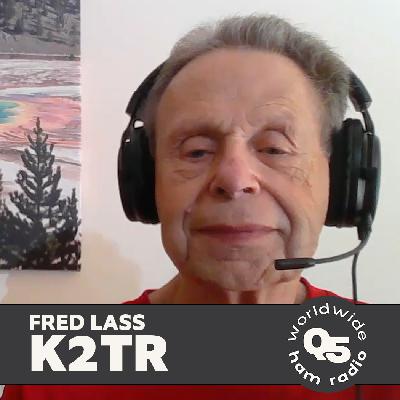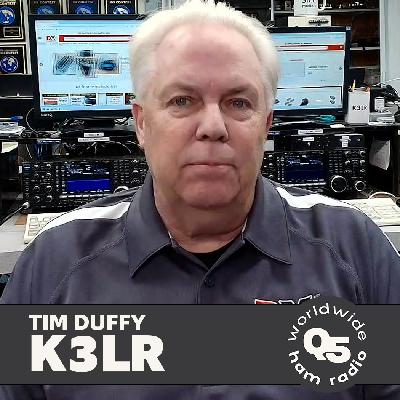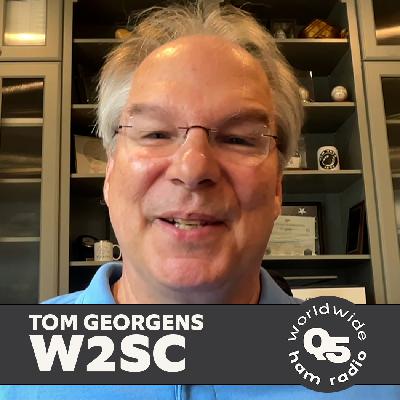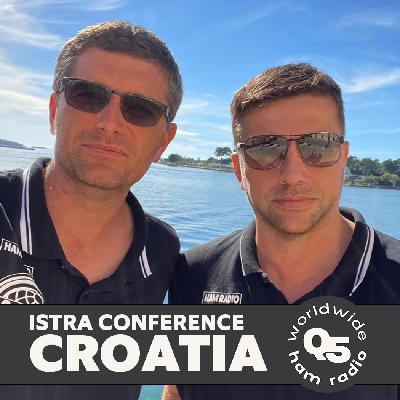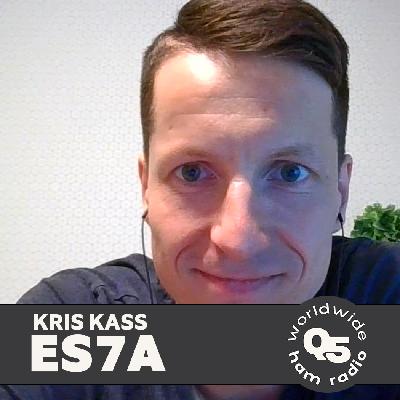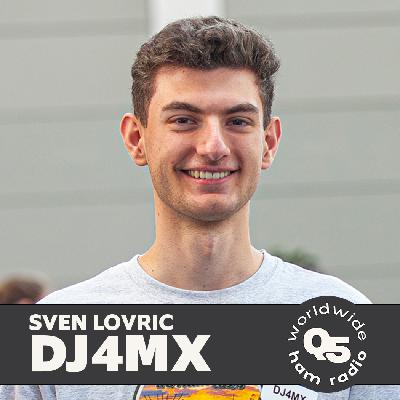Discover Q5 Worldwide Ham Radio
Q5 Worldwide Ham Radio

Q5 Worldwide Ham Radio
Author: Kevin Thomas
Subscribed: 9Played: 431Subscribe
Share
© Copyright 2023 All rights reserved.
Description
Q5 Worldwide Ham Radio sets a new standard in amateur radio media. Through longform interviews, sharp technical insight, and global storytelling, we explore the people and ideas shaping the future of the hobby. From top-tier contesters to everyday ops, Q5 dives into what makes ham radio personal, competitive, and endlessly compelling. New episodes feature behind-the-scenes station builds, SO2R deep dives, WRTC prep, Parks on the Air, HamSCI, and honest talk from the world's most dedicated operators. Proudly supported by DX Engineering and Icom —helping hams stay loud, connected, and ready for the next challenge. Subscribe for real conversations at the edge of the hobby.
165 Episodes
Reverse
Fred Lass K2TR is a legend by reputation and by record—once dubbed “King Fred” during the founding days of YCCC, a title he wears with his usual self-effacing humor. From a modest childhood in Niagara Falls to a career in broadcast engineering, Fred built a life around RF. A licensed ham since the 1960s, he’s revered for his antenna mastery with technical talks that still pack rooms at Dayton Hamvention and Northeast HamX. He’s an original Murphy’s Marauder and a founding voice of what became the powerhouse Yankee Clipper Contest Club. Fred's technical chops aren’t just theoretical. As chief engineer at a broadcast station in the 1970s, he saved his employer hundreds of thousands of dollars by designing a circularly polarized antenna upgrade that required no new tower—a feat of RF and mechanical design rooted in skills honed through ham radio and a degree from RPI. Today, he’s still pushing boundaries, planning an ambitious VU4 Andaman Islands DXpedition with antenna arrays designed for the unique circumstances of that location—challenging propagation paths, remote logistics, and in-band station isolation. And, you'll find him contesting with the multi-multi titan, K3LR. Thanks to Icom for sponsoring Q5 Worldwide Ham Radio—because legendary QSOs deserve legendary radios. Join the conversation and subscribe to Q5 Worldwide Ham Radio.
Ranko Boca 4O3A is a force in global contesting and amateur radio innovation. From his breathtaking hilltop QTH in Montenegro—accessible only by rugged vehicles or his personal helicopter—Ranko has redefined what it means to build a world-class station. A telecom engineer by training and a contester since the 1970s, his early days were shaped by club stations and soldering irons. Today, he leads SkySat and the 4O3A product line, home to cutting-edge hardware like the Power Genius XL and Station Genius—gear that’s reshaped high-performance amateur radio. After a stint in broadcast engineering and a war-disrupted career that took him to Hungary, Ranko returned to Montenegro with a singular vision: build not just a top-tier contest station, but a company that delivers "broadcast-grade" equipment to hams worldwide. His station, nearly destroyed by wildfire in 2017, is now being rebuilt—bigger, tougher, and smarter than before. He calls it “living in a big radio club,” and he means it literally: 4O3A’s R&D is as much about passion as it is about profit. In contesting, Ranko doesn’t shy from strong opinions. He’s called for bold changes in the CQ World Wide rules: shorter operating times for health and fairness, equal QSO points to level the geographical playing field, and a new "Single-Op Two Band" category to democratize high-level competition. And while he refuses to name a definitive “third best” contester in the world, his praise for legends like N5TJ and K1TO—and for regional masters like YT6W and YT7AW—shows he’s thinking globally, but never forgets home. Join the conversation and subscribe to Q5 Worldwide Ham Radio. Special thanks to DX Engineering, whose support of ambitious operators—from Parks on the Air to top-level contesters—keeps this hobby pushing the limits, from the mountaintops of Montenegro to basement shacks worldwide.
HamSCI just completed its first-ever multi-day field exercise at the world-class K3LR contest station in West Middlesex, PA. For four days, students, professors, researchers, and volunteers came together to install components of the Personal Space Weather Station (PSWS), explore the physics behind HF communication, and experience the hospitality of station owner Tim Duffy K3LR. In this interview with HamSCI founder Dr. Nathaniel Frissell, we go inside the project: from pounding ground rods and deploying a DX Engineering active receive antenna, to configuring the RX888 wideband SDR and seeing the first live data roll in. You’ll also hear about the camaraderie, the antenna farm tour, and even the first-ever QSOs made by new hams at K3LR. This is more than a technical milestone—it’s a glimpse at how amateur radio connects science, education, and community. A special thanks to DX Engineering for their support of HamSCI and this project. DX Engineering—trusted by contesters, DXers, and portable operators worldwide.
In this episode of Q5 Worldwide Ham Radio, Kevin Thomas W1DED travels (virtually) to Malawi to hear the remarkable story of Don Jones 7Q6M (K6ZO). From his base at the Embangweni Mission Hospital, Don has spent years operating on HF, mentoring young operators, and helping grow a national amateur radio community in Malawi. We talk about the challenges of building a station where parts and power are scarce, how the Malawi Project became a pipeline for new operators, and how the Jeffrey Dahn Memorial Foundation now carries forward the mission of training African youth in electronics and radio. Along the way, you’ll hear how partnerships with groups like W3HAC and Yasme Foundation, plus support from the broader amateur radio community, have made a lasting impact. Amateur radio isn’t just about contacts—it’s about transforming lives. Don’s story shows how a signal from rural Africa can inspire the next generation of operators worldwide. Sponsored by DX Engineering. From contest superstations to mission-hospital setups in Malawi, DX Engineering provides the gear that keeps amateur radio operators on the air. Trusted by DXers, contesters, and portable operators around the globe. https://www.dxengineering.com
I'm joined by Chris Hurlbut KL9A, Dan Craig N6MJ, Randy Thompson K5ZD, and Bill Fehring W9KKN for another episode of our popular Q5 Contest Crew series—your backstage pass to the minds and methods of ham radio’s top contesters. Randy is deep into a full station rebuild in Ohio, cranes and all, with a shiny new PGXL amp and a garage full of cables he’s still trying to decode. Dan, meanwhile, operated WAE remotely from N2QV, reveling in a seamless K3-to-K3 setup—but bailing to the spa when solar flares ruined the bands. Chris is juggling Montana wildfire prep and fall contest training, while Bill is mid-move from California to Illinois, paring down old projects and dropping 30 pounds ahead of CQP. The main event: SO2R and 2BSIQ. From legacy Microham boxes to rare YCCC kits and elegant DIY rigs from K6AM, the crew breaks down what works, what doesn’t, and why audio switching is more about what’s between your ears than your radios. For newer ops, it’s a masterclass; for veterans, it’s a reminder that even the pros keep refining. They close with fall CQ Worldwide plans—ZF1A, CQ9A, V47T—and WRTC pairings for England, including the headline: Dan and Chris are teaming up again. Let the trash talk commence. Join the conversation and subscribe to Q5 Worldwide Ham Radio. Big thanks to DX Engineering for backing contesters, DXers, and portable ops with the tools and tech to stay loud and competitive across the globe.
Pat Barkey N9RV is a Contest Hall of Famer whose radio journey began with a childhood plan to stay connected to his best friend over a summer apart. What started as a search for CB radios led him instead to a neighbor’s ham shack — and into a lifelong obsession with CW, contesting, and station building. First licensed in 1967, Barkey quickly found himself handling traffic in Michigan and later immersed in the competitive scene at the University of Michigan, surrounded by future contesting greats like K8QKY and N4KG. Now operating from Montana, Barkey is a consummate station builder and CW competitor with four custom-built multi-tower stations to his name. He's one of the rare contesters more likely to be found with a wrench in hand than chasing someone else’s dream station. His career is defined not just by operating skill — though he's racked up plenty of Top Ten finishes and WRTC appearances — but by a deep, practical understanding of the hardware and human connections that power contesting. In May 2025, Barkey was inducted into the CQ Contest Hall of Fame — a recognition not just of his wins, but of his ethos: contesting as a vehicle for friendship, storytelling, and technical curiosity. From his early days in Michigan to his joke-filled rivalry with KL9A in Montana, Barkey embodies the spirit of radiosport — competitive, collaborative, and never quite finished building. Join the conversation and subscribe to Q5 Worldwide Ham Radio. This episode of Q5 Worldwide Ham Radio is powered by Icom—innovative radios trusted by amateur operators across the globe.
Stuart Crawford VE9CF is… a Canadian ham with a military past, a marketer’s mind, and a newfound mission to tell stories through amateur radio. First licensed in the ‘90s as VE4SRC, Stuart’s callsign changed with each military posting—from Manitoba to Alberta to New Brunswick. But the hobby took a 30-year backseat as career and family took the wheel—until recently, when he returned to radio with fresh focus and a two-letter callsign that nods to his time in the Canadian Forces. What began as simple Parks on the Air activations quickly evolved into something deeper. Stuart realized that many historic locations—churches, forts, battlegrounds—were missing from existing portable ops programs. So he built his own. Historic Sites on the Air (hsota.org) is now a growing initiative that invites hams to activate places that matter—not just for their scenery, but their stories. His gear is classic field-ready: FT-891s, lithium batteries, and antennas chosen for the setting—from a Buddipole to a truck-mounted ATAS. But the real hook isn’t the equipment—it’s the ethos. Whether he’s operating near an 1850s church or a remote Acadian fort, Stuart’s goal is the same: protect the site, share the history, and get a few good contacts while you’re at it.
Join the conversation and subscribe to Q5 Worldwide Ham Radio. Many thanks to DX Engineering for backing operators who bring ham radio into new places—whether that’s a battlefield in New Brunswick or a lighthouse off Halifax. Their support helps make activations like Stuart’s possible.
Neil Rapp WB9VPG is amateur radio’s original prodigy—and one of its most effective modern mentors. At age five, Neil became the youngest person ever to earn an FCC ham license, a novelty that landed him in the National Enquirer and on the cover of international ham radio magazines. But celebrity wasn’t the point. The point was code, conversation, and community. And Neil has spent a lifetime making sure the next generation of hams can find all three.
As a high school chemistry teacher, Neil infused radio into the curriculum, making the electromagnetic spectrum tangible—and contagious. He also built a thriving afterschool program where kids spun the dial, called CQ, and taught each other. That peer-to-peer ethos now defines Youth on the Air (YOTA) in the Americas, where Neil serves as camp director. Instead of lectures, campers lead. Instead of stars, YOTA cultivates satellites—young operators who can teach, inspire, and run the show.
This episode covers the origins of YOTA in North America, how camps rotate between countries like Canada, the U.S., and potentially Argentina, and what it costs (spoiler: $100). We also meet the backbone of the organization: former campers now running ops, building websites, managing QSL cards, and even directing the camp’s future. “I'm working hard to put myself out of a job,” Neil says. He means it. And it shows.
Join the conversation and subscribe to Q5 Worldwide Ham Radio.
Thanks to DX Engineering for supporting operators young and old, and for fueling the spirit of ham radio through contesting, Parks on the Air, and so much more.
Doug Grant K1DG is a seasoned contester whose career spans six WRTCs, operations from over 30 countries, and a long-standing USA record in the CQ 160 contest. From his early days in suburban Boston, Doug’s path wound through legendary multi-op stations like W2PV and milestone efforts such as co-founding WWROF and organizing WRTC 2014. His reputation in the contesting community rests not just on scores, but on consistency, mentorship, and a deep commitment to the craft.
Doug’s start came through a Boys' Life crystal radio project in 1965. A spark of curiosity became a full-fledged passion, nudged along by supportive parents and early mentors like K1RX. His operating resume includes record-setting runs from HI8, PJ4, and VP2E, and he’s known for navigating unfamiliar DX stations with calm adaptability. Whether climbing towers or knocking on doors in Guadeloupe with coax in hand, Doug leans into radio with a mix of humility and resolve.
A formative moment came during an early contest, when the top operator in Doug’s local radio club turned to him mid-run and said, “Relax. This is supposed to be fun.” That ethos—balanced by a relentless curiosity—still defines Doug’s approach. Though no longer chasing single-op records, he remains active, engaged, and reflective about contesting’s future.
Join the conversation and subscribe to Q5 Worldwide Ham Radio.
Thanks to DX Engineering for backing Q5 and for championing contesters, DXpeditioners, and everyday operators pushing the limits of portable and fixed stations alike.
Bart Bzymek SQ1K is a Polish ham radio operator who’s stitched together two worlds—DXing and design—into a life as precise as the embroidery he’s known for. He began as a shortwave listener in the 1990s and quickly climbed through Poland’s licensing system, earning his first-class ticket by mastering CW. A dedicated contester, Bart has logged serious time on-air, including stints as a guest op with the Polish HQ team at IARU.
But it’s his embroidery business—launched with a single-needle machine as a side hobby—that’s made him a go-to figure in the global ham community. Since 2014, Bart and his wife have run a custom embroidery shop focused exclusively on amateur radio. With multiple machines and a worldwide client base, they create everything from personalized polos to DXpedition gear—each piece thoughtfully designed and precisely stitched. He’s outfitted some of the most prominent expeditions, including the striking 3Y0K Bouvet logo. In this episode, Kevin W1DED and Bart SQ1K formally announce a new partnership to launch official Q5 merchandise, bringing Bart’s craftsmanship into the heart of the show. Bart’s story is a reminder that amateur radio thrives on passion—and sometimes, a really good hoodie.
Join the conversation, subscribe to Q5 Worldwide Ham Radio, and order your Q5 apparel today.
Thanks to DX Engineering for backing hams around the globe—from park activators to DX chasers—with gear that delivers when it counts.
Tim Duffy K3LR is a powerhouse in the contesting world—CEO of DX Engineering, founder of Contest University, host of the formidable K3LR station—but here, he joins us as the chairman of the World Wide Radio Operators Foundation (WWROF), the engine behind some of competitive ham radio’s best infrastructure and largest radiosport contests. If you’ve received a plaque from CQ WW, trusted your submitted log to be reviewed properly, or been impressed with fast results turnaround, WWROF, with many dedicated volunteers, made it happen. This is the story of how a handful of contesting experts turned fragmented efforts into a global support system for events like CQ WW, CQ WPX, and many others.
Founded in 2009, WWROF began by filling in the gaps: managing contest logistics, streamlining communications, and ensuring continuity for legacy contests. Under Tim’s leadership—and backed by an impressive board of directors—it evolved into something more nimble and visionary. Whether it's mailing awards with record speed, funding youth programs like YOTA camps around the world, or stepping up after disasters like the hurricane in Puerto Rico, WWROF delivers—quietly, effectively, and with zero paid staff. One standout project: their backing of KC2G’s propagation tools, now essential to operators across the spectrum.
Beyond contesting, Tim sees WWROF’s role expanding: finding common ground with Parks on the Air activities, integrating digital modes like FT8, and staying agile in a rapidly changing hobby. He’s not afraid to acknowledge contest community debates—assisted vs. unassisted, real-time scoring—and welcomes them as signs of a dynamic, evolving culture. At its core, WWROF isn’t just a foundation. It’s a model of how small but experienced teams can help shape the future of amateur radio.
Check out the WWROF website at WWROF.org.
Join the conversation and subscribe to Q5 Worldwide Ham Radio.
Thanks to DX Engineering for their steadfast support—not just of Q5, but of youth operators, contesters, and everyday DXers across the globe. Their investment in the ham community makes conversations like this possible.
Tom Georgens W2SC, also known as 8P5A, has a wall of plaques that reflect not just his victories—but the decades of discipline, grit, and quiet precision behind them. While running a Fortune 500 company, he built a formidable contest station in Barbados, troubleshooting in the tropical heat and chasing perfection from one contest season to the next.
In this wide-ranging conversation, Tom shares how he went from a borrowed rental shack to designing and operating a world-class station of his own. He speaks openly about the emotional lows—twice collapsing before the end of a major contest—and the persistence that brought him back to win CQ WW SSB outright. This isn’t just a story about radios and rate sheets. It’s about risk, resilience, and the discipline to rebuild when most would walk away.
Tom also takes us inside the 8P5A station—engineered for “no knobs” operation and built for efficiency at scale. From writing custom software to wrangling antennas in the rain, he explains how contesting sharpened his leadership, kept him grounded under pressure, and still pushes him to evolve. His reflections on preparation, intuition, and the future of ham radio are as thoughtful as they are hard-won.
Whether you’re chasing plaques, personal bests, or simply trying to understand what drives the best—this one’s worth your time. Join the conversation and subscribe to Q5 Worldwide Ham Radio.
Thanks to DX Engineering for supporting the operators who never stop pushing—whether they’re building from scratch, rebuilding after storms, or reimagining what a contest station can be.
After our deep dive into W3AO’s record-breaking Field Day operations, we came back with one simple question for Frank W3LPL and Rol K3RA: What radios actually get the job done—and which ones are banned—at Field Day? Their answers might surprise you.
Field Day means different things to different hams. For some, it’s a competition—a chance to test gear, strategy, and skill. When we spoke with the W3AO team about their 28-year run of record-breaking efforts, we celebrated that spirit. But Field Day can also look like this: lawn chairs in a field, lawn mowing, antenna builds, and a loose pact that everyone makes at least one QSO—if they feel like it.
At KM7W in rural Montana, Chris Hurlbut KL9A and Dan Craig N6MJ—two of the most respected contesters in amateur radio—set aside the race for rate and mults. Instead, they invited family, friends, and fellow ops to simply enjoy the experience. Some flew in, others drove across the country. Together they raised antennas, told stories around the firepit, dodged rattlesnakes, and made over 3,000 contacts—without ever writing a shift schedule.
Levi’s improvised satellite station—with a last-minute-built handheld yagi—became the hit of the weekend. At 2:30 a.m., they tracked the International Space Station under the stars, calling out headings while trying not to wake the others. That’s Field Day, too.
Join the conversation and subscribe to Q5 Worldwide Ham Radio for more stories like this, where signal reports matter—but so do the people behind the mic and the ones behind the op.
Thanks to DX Engineering, whose support helps fuel every version of Field Day—from the multi-multi juggernauts to backyard ops with just enough coax and a cooler of cold drinks.
Gregg Marco W6IZT has participated in some of ham radio’s most well-known DXpeditions—and a few dozen vacation-style ones too. From his ridge-top shack in rural Georgia, he’s spent the last two decades blending deep technical chops with a passion for the hobby. But his latest venture—PJ6Y from Saba Island—isn’t just another stamp in the logbook. It’s the next step in a generational handoff that began with 3D2Y Rotuma.
In this episode, W6IZT joins Q5 to talk about how, at 70 years old, his approach to DXpeditioning is all about putting young operators in charge. His new model leans into mentorship and real-time problem solving. The PJ6Y team includes first-time DXpeditioners from nine countries. Thanks to partnerships with Youth on the Air and a growing off-island remote crew operating through Next Gen RIBs, they’re learning what it really takes to build, troubleshoot, and run an expedition.
Gregg recounts the spark that started it all (his wife, Wendy), the stethoscope used to diagnose a seawater-soaked tuner, and themakeshift shelter roof ripped off mid-contest. These aren’t just stories—they’re signals of a deeper shift. With young hams now leading workshops, designing station schedules, and preparing for future trips with no “old man” supervision, W6IZT is quietly rewriting what it means to be seasoned.
Join the conversation—and subscribe to Q5 Worldwide Ham Radio to follow the voices shaping the future of DXing.
Special thanks to DX Engineering for supporting the innovators, mentors, and adventurers pushing the boundaries of what’s possible in amateur radio—wherever in the world they may be.
The Contest Crew is back—Randy K5ZD, Dan N6MJ, Chris KL9A, and Bill W9KKN—fresh off the IARU HF World Championship. From broken antennas and overheated shacks to surprise guest ops and last-minute tech rescues, this episode captures the contest highs, lows, and hard-won wisdom only this crew can deliver.
Dan N6MJ’s operation from the legendary N2QV station in New York almost didn’t happen. After casually mentioning on a previous Q5 episode that he was “without a station,” Dan got an unexpected email from Tariq N2QV—inviting him to operate from one of the country’s top single-op sites. That led to a last-minute cross-country flight, a borrowed “foot switch” taped to the floor, and a serious attempt at the USA record. The band conditions didn’t hold up, but the effort, camaraderie, and unexpected help—from past Q5 guest Sebastian KI2D to Bill’s remote troubleshooting—tell a bigger story.
Meanwhile, Chris KL9A battled 96-degree heat and bug-filled Montana nights with his trademark grin, chasing WRTC test stations and savoring every contact. Randy K5ZD, mid-rebuild in Ohio, strung up dipoles and made the most of a casual effort. And Bill W9KKN—unofficially the Contest Crew’s 24/7 tech support—spent the weekend solving problems for everyone from N2NT and NP4Z to Dan at N2QV. Whether comic or crushing, each story points to what this Crew knows best: the contest never really ends—and neither does the bond among operators.
This episode is a candid debrief with four of the world’s top contesters. Join the conversation and subscribe to Q5 Worldwide Ham Radio.
Thanks to DX Engineering for backing contesters, DXers, POTA activators, and everyone pushing ham radio forward—rain or shine, band open or closed.
Clarification: In the discussion about the N2QV antennas, there was a question regarding who designed and built the 4-high stack of 2X Array Tribanders. To clarify, those antennas were exclusively designed, optimized, and built by Scott, WU2X. Full credit for that impressive work goes to him.
The ISTRA Contest Conference is taking place October 9–12th in Poreč, Croatia, and Braco E77DX, Mirko 9A6KX, and Dave 9A1UN are here to tell us all about it. Born from late-night conversations and a desire for deeper community, the ISTRA Contest Conference is quickly becoming Europe’s most vital gathering of contest operators. What started as a bold idea between friends has evolved—despite COVID delays—into a globally attended, three-day immersion in radiosport. With over 250 participants and growing interest from outside the Balkans, the event now draws contesters from across Europe, the Middle East, and even the U.S. But this isn’t Friedrichshafen or Dayton. There are no booths. No gear to buy. Instead, ISTRA offers live, interactive presentations: young operators debriefing DXpeditions, station builders explaining the guts of their setups, doctors addressing health in contesting, and yes—even discussions on the etiquette (and humor) of stealing frequencies from people you now consider friends. The tone is intimate and deeply human, with late-night “last-man-standing” competitions that blend camaraderie with contest-hardened stamina. Held on the stunning Istrian coast, ISTRA isn’t just for contesters—it’s also a rare invitation for spouses and families to enjoy world-class food, swim in the Adriatic, and savor the wines and quiet beauty of inland Croatia. This episode builds on earlier Q5 conversations with top operators and expedition teams, but shifts the focus to what happens off the air—when contesters come together to share war stories, swap tactics, and reimagine the future of the sport. Join the conversation and subscribe to Q5 Worldwide Ham Radio for more stories like this. Special thanks to DX Engineering for supporting contesters, DXers, Parks on the Air activators, and every ham who knows the thrill of calling CQ from somewhere new.
Our Contest Crew Europe introductions continue with Kris Kass ES7GM, also known by ES7A. Kris is a third-generation Estonian ham radio operator whose story arcs from Soviet-era restrictions to modern contesting excellence. Raised in a family where CW was practically a second language—his grandfather operated behind the Iron Curtain as UR2GT (during Soviet times, all of Estonia used the UR2 prefix)—Kris made his first CW contact at age seven using a straight key and what he remembers as a “messy” transmission. Now in his thirties, he’s one of Estonia’s most respected contesters, equally at home running pileups from his self-built rural station or contributing big scores from the megastation ES5TV.
What sets Kris apart isn’t just his lineage or results, but his philosophy. At a time when many are chasing ever-bigger setups, he made a deliberate shift—constructing ES7A with simplicity and sustainability in mind. Using salvaged Soviet towers and homemade antennas, he built a flexible station atop his region’s highest local terrain—not to rival ES5TV, but to offer something community-driven and distinctly his. “It’s not about competition,” he says. “It’s about having something locals can use.”
A moment that lingers: Kris casually mentions his ability to transmit and receive at the same time—a rare skill that helped him rack up 357 QSOs in the first hour of a recent IARU contest using SSB 2BSIQ. As former president (2018–2024) of the Estonian Amateur Radio Union, he championed online exams and helped build a pipeline for young operators. The results are already visible.
This episode builds on a growing thread at Q5—highlighting a new generation of builders and operators like Kris Kass and Kristers Misa YL3JA, his WRTC 2026 teammate. Join the conversation and subscribe to Q5 Worldwide Ham Radio to follow more stories like this.
A big thanks to DX Engineering, whose support helps fuel the creativity of DXers, contesters, Parks on the Air activators, and ops everywhere—especially those who build stations from rusted towers and quiet determination.
Dave Kucelin 9A1UN, also known by his contest call 9A1P, is one of the most accomplished HF contesters in Croatia and the tenacious force behind a station that’s endured devastating storms, unresolvable land disputes, and a rotating cast of club members—all while racking up thousands of QSOs. In this episode, Dave opens up about building (and rebuilding) the 9A1P contest station, a decades-long project that started with five-element yagis on a 30-foot tower and evolved into a rugged, sea-facing setup now spanning four towers on a ridge above the Adriatic Sea. A third-generation ham, Dave first got on the air using his father’s call at age six. He cut his teeth on VHF contests, but it was CQWW that pulled him toward HF. After a freak storm in 2018 leveled the original station, Dave and his small team were forced to start over—only to be evicted from the land they’d occupied for 30 years. (Yes, there’s more to the story.) What followed was a two-year hunt for a new site, culminating in a station perched above a river valley with sea paths to North America and Japan, optimized with fixed antennas built to withstand the region’s brutal winds. The story is full of grit and unexpected laughs—like the time Dave hung a tribander between two towers with rope just to beam east for ARRL SSB, or his candid take on remote operation and the fear it might kill the camaraderie he treasures most. His daughter, now licensed and active in the YOTA scene, marks the family’s fourth generation on the air. Join the conversation and subscribe to Q5 Worldwide Ham Radio—where we're working hard to illuminate the wonderful world of ham radio. Special thanks to DX Engineering for supporting the global ham radio community—from trailblazing POTA activators to teams pushing the limits in the world’s toughest DX and contesting environments. Your gear powers the pursuit.
Sven Lovric DJ4MX is part of a new wave of contesters and DXpeditioners reshaping what youth, excellence, and ambition look like in ham radio today. At just 23, he’s already logged pileups from Guyana and the remote Pacific outpost of the Marshall Islands. Whether operating as 8R7X or V73WW, Sven thrives in the thick of it—chasing signals from the other side of the globe, running high-rate phone pileups, and mastering CW through sheer commitment and countless hours on Morse Runner.
Our conversation traces his journey from a 13-year-old operating under Germany’s training license program to a top finisher in CQ Worldwide CW from a 100-watt station in the heart of Munich. While his roots lie in family outings and early SOTA activations, his heart now belongs to contests and DXpeditions. He favors single-op low power for the raw challenge—but you can see the glimmer in his eyes when he talks about future high-power opportunities. His most formative experiences—like operating from E7DX with Braco or field-cooking between shifts in the Marshalls—reveal a camaraderie at the core of these far-flung efforts.
Sven’s voice is both young and unusually thoughtful. He champions the live scoreboard as a tool for growth, not ego, and offers a clear call to action: don’t just study radio—operate. That advice, he notes, applies as much to midlife returners as it does to teenage prodigies. And while he isn’t ready to reveal where the “Next Generation DX Team” is heading next, one thing is certain—they’re not done.
Join the conversation and subscribe to Q5 Worldwide Ham Radio for more interviews with the voices shaping amateur radio’s future.
Thanks to DX Engineering for supporting this work—and for helping DXers, POTA activators, and contesters everywhere build the stations of their dreams, no matter where they call CQ.
Comments
 United States
United States

